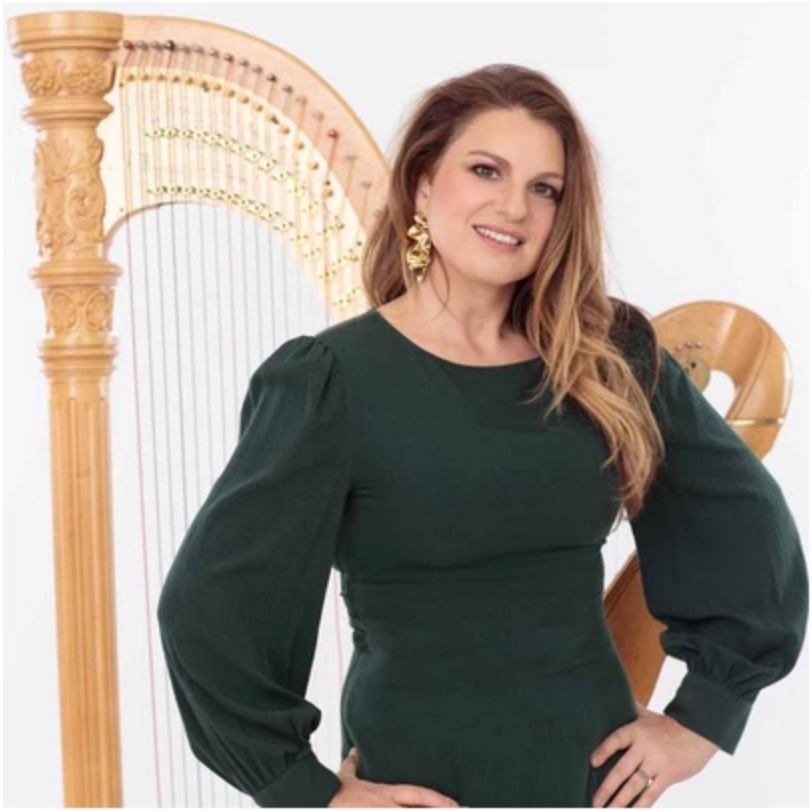by Kevin McLaughlin

Kibbey was also lively with the microphone, giving an engaging introduction to André Caplet’s 1924 Conte Fantastique (Fantastic Tale). After the performance, she mingled among the crowd — not so much a star gesture as a genuine one that made her performance even more memorable.
Given that André Caplet orchestrated and conducted some of Debussy’s works, many associate the two composers. To say Caplet’s musical language is impressionist-adjacent is partly true but hardly encapsulates his unique, ahead-of-his-time voice.
Kibbey made the most of Caplet’s action-packed work — part harp concerto and part tone poem, based on Edgar Allan Poe’s short story The Masque of the Red Death.
The piece recounts Prospero, a prince living in a palatial abbey, who invites a thousand nobles over to his place for a masquerade ball to avoid the plague of the Red Death. Unfortunately, one of the invited guests is Mr. Death himself, “tall and gaunt and shrouded from head to foot in the habiliments of the grave,” Poe writes. As Kibbey gleefully gave away in her opening remarks, “Everyone dies in the end!”
The harp, it turns out, is uniquely suited to tell this grotesque tale, with its dominant physical presence (turned sideways here for maximum effect), startling tonal and dynamic range, and bag of tricks: harmonics, knocks on the sound board (simulating death’s arrival), and convincing impressions of clock chimes to build the tension. Even the frequent glissandi, a harp staple, came across as menacing rather than heavenly, putting you as close to Red Death as you’d care to be.
Kibbey is a born actress as well as a masterful musician. In addition to her diabolical ease on the harp, she added a sinister smile and a bobbing head, as if possessed. The harp, too, seemed to get in on the act, rocking back and forth like a large puppet. She and her string colleagues — violinists Diana Cohen and Joseph Lin, violist Milena Pajaro-van de Stadt, and cellist Oliver Herbert — had little trouble with Caplet’s prickly, post-impressionist harmonies and scales, or with his start-and-stop tempos. Impending doom contrasted with violent episodes and lots of waltzes, suggesting Prospero’s guests’ blithe indifference toward their fate.
Robert Schumann’s 1843 Andante and Variations in B-flat is a lesser-known work, certainly in part for its unusual grouping of instruments (two pianos, two cellos, and horn). Program annotator Donald Rosenberg put it this way: “How many other pieces can you name with this unique instrumental combination?” Got me there. But it’s rich, sumptuous, and tinged with nostalgia and may have left the audience wondering, why the rarity? Splashes of cello and horn combined with the versatility and range of two pianos — who, let’s face it, did most of the heavy lifting.
The physical arrangement of the pianos, lidless and arranged in a V-shape, gave the impression of lovers holding hands. This no doubt helped to blend both the ensemble and the pianos’ intersecting lines. Pianists Adam Golka and Roman Rabinovich finished one another’s sentences and dovetailed their phrases. Nelson Ricardo Yovera Perez’s horn was kept under wraps by Schumann, except for the one hunting horn variation when Perez got to show off a bit. The matching mahogany hues coming from cellists Annie Jacobs-Perkins and Oliver Herbert added to the texture and contributed layers of warmth.
The star-studded assemblage charged with playing Erich Korngold’s Piano Quintet in E as the program finale maximized the composer’s cinematic bent (he was a successful Hollywood film composer) with swashbuckling high spirits and heart-rending Romanticism.
Pianist Adam Golka provided gusto and subtlety from the start, and first violinist Alexi Kenney ignited the fire, impressing for both his virtuosity and his selfless musicianship. The second movement, with its sudden harmonic and emotional shifts à la Anton Webern, provided opportunities for cellist Annie Jacobs-Perkins and second violinist Jason Yu to apply the color alchemy of their inner voices. Violist Paul Neubauer’s rich, lyrical sound also left the listener with lasting moments of beauty after the credits.
Published on ClevelandClassical.com June 19, 2024.
Click here for a printable copy of this article



